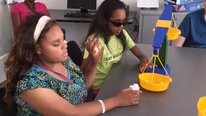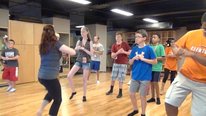- James Lester
- https://www.cei.ncsu.edu/people/lester/
- Director and Distinguished Professor
- Engage
- http://projects.intellimedia.ncsu.edu/engage/
- North Carolina State University, Center for Educational Informatics
- Megan Frankosky
- https://www.cei.ncsu.edu/people/rmhardy/
- Research Psychologist
- Engage
- http://projects.intellimedia.ncsu.edu/engage/
- North Carolina State University, Center for Educational Informatics
- Eric Wiebe
- https://ced.ncsu.edu/people/wiebe/
- Interim Associate Dean for Research and Professor
- Engage
- http://projects.intellimedia.ncsu.edu/engage/
- North Carolina State University, Friday Institute for Educational Innovation
Public Discussion
Continue the discussion of this presentation on the Multiplex. Go to Multiplex









Katie Rich
Curriculum Developer
Hello James, Megan, and Eric,
The student testimonials in the video reference working with partners. How does the Engage game and accompanying curriculum promote collaboration between students?
I was also interested to see that concepts are introduced within the game and then expanded upon during class activities. Has this led any of your participating teachers to use a flipped model, where students complete the game at home the day before class? How has this affected the collaborative aspects of the game?
Megan Frankosky
Research Psychologist
Hi Katie,
Thanks for your comments and questions! One way that the Engage game promotes collaboration between students is by having them use a variation of the pair programming technique. This practice allows each student to take on the role of either a “driver” or a “navigator” during a set of challenges, and then to switch roles for the next set.
The student taking on the role of the driver is responsible for controlling the character movement and interactions within the game, while the student taking on the role of the navigator is responsible for providing direction and advice for what to do next. The game then prompts students to switch roles at pre-determined points during the game. This gives both students in the pair a chance to provide input in different way and work to solve the programming challenges as a team.
Currently, we have not had any teachers use a flipped model, but this is an interesting idea!
Irene Lee
Research Scientist
Hello,
One of the quotes made it seem that teachers were able to customize the game for their students, is this the case? If so, what types of modifications did they make?
Megan Frankosky
Research Psychologist
Hi Irene,
Thank you for this question. Engage does not currently allow teachers to customize aspects of the game for students, but I can see this being a promising feature in future versions!
Wendy Martin
Hi James, Megan, and Eric!
This game looks so beautiful! I’m impressed that these schools do the full 9-week computer science course. Is this designed as a separate computer science unit, or is it designed to be integrated into existing courses like math or science? Or can it be used in either situation?
Megan Frankosky
Research Psychologist
Thank you Wendy, we appreciate the compliments!
We designed the Engage program to be part of a science elective course where the units included both science and computer science class activities and game-based activities. We have also ran the game-based activities as a stand-alone unit centering on computer science principles for middle school students.
Barbara Ericson
This looks very interesting. Is it available for other schools to use? Why did you choose to work with middle school students instead of high school students? The CS Principles course was designed for high school students. Do female students enjoy it as much as male students? What is required to run the game?
Evan Korth
Clinical Professor
I’m also curious about the ratio of boys to girls. The video shows a diverse group of students, but I have seen male students be more attracted to game based platforms in the past. Are you seeing the same? If not, do you have a theory as to why?
Further posting is closed as the showcase has ended.